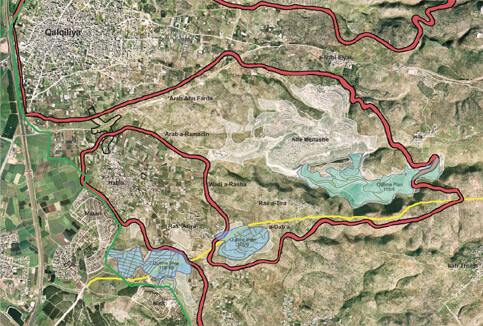
Alfe Menashe: Expansion Plans and the Separation Barrier. (Map: B’Tselem/Bimkom)
The expansion of settlements in the West Bank has been a primary consideration in setting the route of many sections of the Separation Barrier. This is the conclusion of a report released today by B’Tselem and Bimkom: Planners for Planning Rights, following this morning’s High Court decision regarding the Barrier around the settlement of Alfe Menashe. Under the Guise of Security proves that, contrary to the state’s claim that the Barrier’s route is based solely on security reasons, the main consideration in setting the route in some locations was to include on the “Israeli” side of the Barrier areas which are slated for settlements expansion. In some cases, the expansion amounts to the establishment of new settlements.
The report shows that not only were security-related reasons of secondary importance in certain locations, in cases when they conflicted with settlement expansion, the planners opted for expansion, even at the expense of compromised security. This desire for settlement expansion led to an increase in the violation of Palestinians’ human rights.
The report provides an in-depth analysis of the expansion plans in four settlements � Zufin, Alfe Menashe, Modi’in Illit, and Geva Benyamin (Adam)-Neve Ya’akov � and the connection between the plans and the route of the Separation Barrier. The report also presents the principal findings in eight other cases in which the settlement’s expansion plans significantly affected the Barrier’s route: Rehan, Sal’it, Oranit, Ofarim, Ari’el, Qedumim, Gevaot, and Eshkolot.
UNDER THE GUISE OF SECURITY: ROUTING THE SEPARATION BARRIER TO ENABLE ISRAELI SETTLEMENT EXPANSION IN THE WEST BANK
The fact that the Separation Barrier cuts into the West Bank was and remains the main cause of human rights violations of Palestinians living near the Barrier. Israel contends that the Barrier’s route is based solely on security considerations. This report disputes that contention and proves that one of the primary reasons for choosing the route of many sections of the Barrier was to place certain areas intended for settlement expansion on the “Israeli” side of the Barrier. In some of the cases, for all intents and purposes the expansion constituted the establishment of a new settlement.
The report provides an in-depth analysis of the expansion plans of four settlements and the connection between the plans and the route of the Separation Barrier. The report also presents the principal findings in eight other cases in which the settlement’s expansion plans significantly affected the Barrier’s route.
The currently approved route of the Barrier leaves fifty-five settlements, twelve of them in East Jerusalem, separated from the rest of the West Bank and contiguous with the State of Israel. Study of a map of the route indicates that in most of the cases discussed in this report, the Barrier’s route was set hundreds, and even thousands, of meters from the houses at the edge of the settlement. The route of the Separation Barrier running near each of the twelve settlements discussed in the report more or less follows the borders of the outline development plan for the particular settlement, making it impossible to argue there is no connection between the route and the plan. Thus it is clear that contrary to the picture portrayed by the state, the settlement-expansion plans played a substantial role in the planning of the Barrier’s route.
The report shows that not only were security-related reasons of secondary importance in certain locations, in cases when they conflicted with settlement expansion, the planners opted for expansion, even at the expense of compromised security. This desire for settlement expansion led to an increase in the violation of Palestinians’ human rights.
The settlements that Israel established in the Occupied Territories are illegal and breach international humanitarian law. Therefore, an act intended to perpetuate the settlements is by definition, a breach of international law. Although protecting the settlers is a legitimate objective, achieving it by running the Barrier along a route that perpetuates the settlements or involves expressly forbidden acts, such as destruction of private property, is illegal. The severity of the action is aggravated insofar as the primary goal in setting the Barrier’s route - expanding settlements and protecting the economic interests of Israeli real-estate developers - is itself illegal.
Related Links